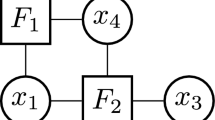Abstract
The k-center problem arises in many applications such as facility location and data clustering. Typically, it is solved using a branch and bound tree traversed using the depth first strategy. The reason is its linear space requirement compared to the exponential space requirement of the breadth first strategy. Although the depth first strategy gains useful information fast by reaching some leaves early and therefore assists in pruning the tree, it may lead to exploring too many subtrees before reaching the optimal solution, resulting in a large search cost. To speed up the arrival to the optimal solution, a mixed breadth-depth traversing strategy is proposed. The main idea is to cycle through the nodes of the same level and recursively explore along their first promising paths until reaching their leaf nodes (solutions). Thus many solutions with diverse structures are obtained and a good upper bound of the optimal solution can be achieved by selecting the minimum among them. In addition, we employ inexpensive lower and upper bounds of the enclosing balls, and this often relieves us from calling the computationally expensive exact minimum enclosing ball algorithm. Experimental work shows that the proposed strategy is significantly faster than the naked branch and bound approach, especially as the number of centers and/or the required accuracy increases.













Similar content being viewed by others
References
Acharya, T., Ray, A.K.: Image Processing: Principles and Applications. Wiley, New York (2005)
Agarwal, P.K., Procopiuc, C.M.: Exact and approximation algorithms for clustering. In: Proc. 9th ACM-SIAM Symposium on Discrete Algorithms, pp. 658–667 (1998)
Bǎdoiu, M., Har-Peled, S., Indyk, P.: Approximate clustering via core-sets. In: Proc. 34th Annual ACM Symposium on Theory of computing (STOC’2002), pp. 250–257 (2002)
Bǎdoiu, M., Clarkson, K.L.: Smaller core-sets for balls. In: Proc. 14th Annual ACM-SIAM Symposium on Discrete Algorithms, pp. 801–802 (2003)
Bilò, V., Caragiannis, I., Kaklamanis, C., Kanellopoulos, P.: Geometric clustering to minimize the sum of cluster sizes. In: Proc. of the European Symposium on Algorithms. LNCS, vol. 3669, pp. 460–471 (2005)
Blake, C.L., Merz, C.J.: UCI repository of machine learning databases. Dept. Inf. Comput. Sci., Univ. California, Tech. Rep. (1998). http://archive.ics.uci.edu/ml/datasets
Brandenberg, R., Roth, L.: New algorithms for k-center and extensions. J. Comb. Optim. 18, 376–392 (2009)
Cook, W.J.: National traveling salesman problems. http://www.tsp.gatech.edu/world/countries.html
Duda, R.O., Hart, P.E., Stork, D.G.: Pattern Classification, 2nd edn. Wiley, New York (2001)
Farahani, R.Z., Hekmatfar, M.: Facility Location: Concepts, Models, Algorithms and Case Studies. Physica-Verlag, Heidelberg (2009)
Fowler, R.J., Paterson, M.S., Tanimoto, S.L.: Optimal packing and covering in the plane are NP-complete. Inf. Process. Lett. 12, 133–137 (1981)
Gonzalez, T.F.: Clustering to minimize the maximum intercluster distance. Theor. Comput. Sci. 38, 293–306 (1985)
Hastie, T., Tibshirani, R., Friedman, J.H.: The Elements of Statistical Learning: Data Mining Inference, and Prediction. Springer, Berlin (2001)
Jain, A.K., Dubes, R.C.: Algorithms for Clustering Data. Prentice Hall, New York (1988)
Jain, A.K., Murthy, M.N., Flynn, P.J.: Data clustering: a review. ACM Comput. Rev. 31(3), 264–323 (1999)
Kowalski, G.: Information Retrieval Architecture and Algorithms. Springer, Berlin (2010)
Kumar, P., Mitchell, J.S.B., Yildirim, A.: Computing core-sets and approximate smallest enclosing HyperSpheres in high dimensions. In: Proc. 5th Workshop on Algorithm Engineering and Experiments, pp. 45–55. SIAM, Philadelphia (2003)
Kumar, P., Mitchell, J.S.B., Yildirim, A.: Approximate minimum enclosing balls in high dimensions using core-sets. ACM J. Exp. Algorithmics 8, 1–29 (2003)
Kumar, P.: Clustering and reconstructing large data sets. PhD thesis, Department of Computer Science, Stony Brook University (2004)
Kumar, P., Kumar, P.: Almost optimal solutions to k-clustering problems. Int. J. Comput. Geom. Appl. 20(4), 431–447 (2010)
Lev-Tov, N., Peleg, D.: Polynomial time approximation schemes for base station coverage with minimum total radii. Comput. Netw. 47, 489–501 (2005)
Megiddo, N.: Linear-time algorithms for linear programming in R 3 and related problems. SIAM J. Comput. 13, 759–776 (1983)
Megiddo, N., Supowit, K.J.: On the complexity of some common geometric location problems. SIAM J. Comput. 13, 182–196 (1984)
Mehrotra, S.: On the implementation of a primal-dual interior point method. SIAM J. Optim. 2(4), 575–601 (1992)
Reinelt, G.: TSPLIB, a traveling salesman problem library. ORSA J. Comput. http://comopt.ifi.uni-heidelberg.de/software/TSPLIB95
Acknowledgements
We would like to thank René Brandenberg for providing several data sets for the experiments.
Author information
Authors and Affiliations
Corresponding author
Rights and permissions
About this article
Cite this article
Fayed, H.A., Atiya, A.F. A mixed breadth-depth first strategy for the branch and bound tree of Euclidean k-center problems. Comput Optim Appl 54, 675–703 (2013). https://doi.org/10.1007/s10589-012-9503-x
Received:
Published:
Issue Date:
DOI: https://doi.org/10.1007/s10589-012-9503-x




